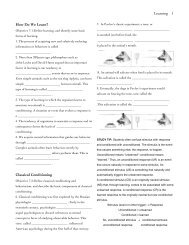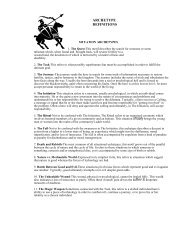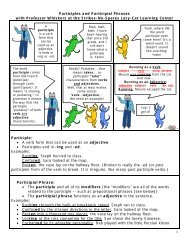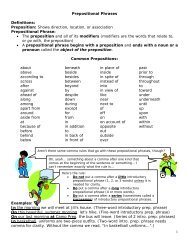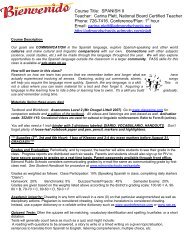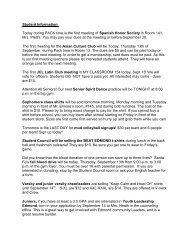READ-ACTING AS IF - Edmond Public Schools
READ-ACTING AS IF - Edmond Public Schools
READ-ACTING AS IF - Edmond Public Schools
You also want an ePaper? Increase the reach of your titles
YUMPU automatically turns print PDFs into web optimized ePapers that Google loves.
<strong>ACTING</strong> <strong>AS</strong> <strong>IF</strong> YOU ARE HYPNOTIZED<br />
Spanos, N. P. (1982). Hypnotic behavior: A cognitive, social, psychological perspective. Research Communications<br />
in Psychology, Psychiatry, and Behavior, 7, 199-213.<br />
The alterations in consciousness with which we are all most familiar are related to sleep and dreaming. The<br />
previous three articles have focused on several highly influential studies relating to these topics. Another<br />
phenomenon relating to altered states of consciousness is hypnosis. Hypnosis is usually seen as a mysterious and<br />
powerful process of controlling a person's mind. The phrases and words that surround hypnosis, such as going<br />
under and trance, indicate that it is commonly considered to be a separate and unique state of awareness, different<br />
from both waking and sleep. And many psychologists agree with this view. Nicholas Spanos (1942-1994),<br />
however, led the opposing view that hypnosis is, in reality, nothing more than an increased state of motivation to<br />
perform certain behaviors and can be fully explained without resorting to trances or altered states.<br />
The beginnings of hypnosis are usually traced back to the middle of the eighteenth century, a time when<br />
mental illness was first recognized as resulting from psychological rather than organic causes. One of the many<br />
fascinating characters who helped bring psychology out of the realm of witchcraft was Franz Anton Mesmer<br />
(1733-1815). He believed that hysterical disorders were a result of imbalances in a universal magnetic fluid present<br />
in the body. During strange gatherings in his laboratory, soft music would play, the lights would dim, and<br />
Mesmer, clothed like a sorcerer, would take iron rods from bottles of various chemicals and touch parts of the<br />
afflicted patients' bodies. He believed that this would transmit what he called the animal magnetism in the<br />
chemicals into the patients and provide relief from their symptoms. Interestingly, history has recorded that in<br />
many cases this treatment appeared to be successful. It is from Mesmer that we acquired the word mesmerize, and<br />
many believe that his treatment included some of the techniques we now associate with hypnosis.<br />
Throughout the history of psychology, hypnosis (named after Hypnos, the Greek god of sleep) has<br />
played a prominent role, especially in the treatment of psychological disorders, and it was a major component in<br />
Freud's psychoanalytic techniques. Ernest Hilgard has been at the forefront of modern researchers who support<br />
the position that hypnosis is an altered psychological state (Hilgard, 1978). His and others' descriptions of<br />
hypnosis have included characteristics such as increased susceptibility to suggestion, involuntary performance of<br />
behaviors, improvements in recall, increased intensity of visual imagination, dissociation (the ability to be aware<br />
of some conscious events while being unaware of others), and analgesia (lowered sensitivity to pain). Until<br />
recently, the idea that hypnosis is capable of producing thoughts, ideas, and behaviors that would otherwise be<br />
impossible and that it is an altered state of consciousness has been virtually undisputed.<br />
However, it is the job of scientists to look upon the status quo with a critical eye and, whenever they see<br />
fit, to debunk common beliefs. Just as Hobson and McCarley proposed a new view of dreaming that was<br />
radically different from the prevailing and popular one, social psychologist Nicholas Spanos has suggested that<br />
the major assumptions underlying hypnosis, as set forth by Hilgard and others, should be questioned. In this<br />
article Spanos wrote, "The positing of special processes to account for hypnotic behavior is not only unnecessary,<br />
but also misleading .... Hypnotic behavior is basically similar to other social behavior and, like other social<br />
behavior, can be usefully described as strategic and goal-directed" (p. 200). In other words, Spanos contended<br />
that hypnotized subjects are actually engaging in voluntary behavior designed to produce a desired consequence.<br />
He further maintained that while such behavior may result from increased motivation, it does not involve an<br />
altered state of consciousness.<br />
THEORETICAL PROPOSITIONS<br />
Spanos theorized that all of the behaviors commonly attributed to a hypnotic trance state are within the normal,<br />
voluntary abilities of humans. He maintained that the only reason people define themselves as having been<br />
hypnotized is that they have interpreted their own behavior under hypnosis in ways that are consistent with their<br />
expectations about being hypnotized. Spanos views the process of hypnosis as a ritual that in Western culture<br />
carries a great deal of meaning. Subjects expect to relinquish control over their own behavior, and as the process<br />
of hypnotic induction develops, they begin to believe that their voluntary acts are becoming automatic,<br />
involuntary events. An example of this that Spanos offers is that early in the hypnotic procedure, voluntary<br />
instructions are given to the subject, such as, "relax the muscles in your legs," but later these become involuntary<br />
suggestions, such as, "your legs feel limp and heavy."<br />
In collaboration with various colleagues and associates, Spanos devoted nearly a decade of research<br />
prior to this 1982 article, demonstrating how many of the effects commonly attributed to hypnotic trances could<br />
be explained just as easily (or even more easily) in less mysterious ways.<br />
1
METHOD<br />
This article does not report on a specific experiment, but rather summarizes numerous studies made by Spanos<br />
and his associates prior to 1982, which were designed to support his position against Hilgard's contention (and<br />
the popular belief) that hypnosis is a unique state of consciousness. Most of the findings reported were taken<br />
from 16 studies in which Spanos was directly involved, and that offered alternate interpretations of hypnotically<br />
produced behavior. Therefore, as in the previous article on dream research, results and the discussion of them<br />
are combined.<br />
RESULTS AND DISCUSSION<br />
Spanos claimed that there are two key aspects of hypnosis that lead people to believe it is an altered state of<br />
consciousness. One is that subjects interpret their behavior as being caused by something other than the self,<br />
thus making the action seem involuntary. The second aspect is the belief discussed previously that the hypnosis<br />
ritual creates expectations in the subject, which in turn motivate the subject to behave in ways that are consistent<br />
with the expectations. The research Spanos reports in this article focuses on how these frequently cited claims<br />
about hypnosis have been drawn into question.<br />
The Belief That Behavior Is Involuntary<br />
As subjects are being hypnotized, they are usually asked to take various tests to determine if a hypnotic state has<br />
been induced. Spanos claimed that these tests are often carried out in such a way as to invite the subjects to<br />
convince themselves that something out of the ordinary is happening. Hypnotic tests involve suggestions such as,<br />
"your arm is heavy and you cannot hold it up"; your hands are being drawn together by some force and you<br />
cannot keep them apart; your arm is as rigid as a steel bar and you cannot bend it; or your body is so heavy that<br />
you cannot stand up. Spanos interpreted these test suggestions as containing two interrelated requests. One<br />
request asks subjects to do something, and the other asks them to interpret the action as having occurred<br />
involuntarily. Some subjects fail completely to respond to the suggestion. Spanos claimed that these subjects do<br />
not understand that they must voluntarily do something to initiate the suggested behavior and instead simply<br />
wait for their arms or body to begin to move. Other subjects respond to the suggestion, but are aware that they<br />
are behaving voluntarily. Finally, there are those subjects who agree to both requests; they respond to the<br />
suggestion and interpret their response as beyond their control.<br />
Spanos suggested that whether subjects interpret their behavior to be voluntary or involuntary depends<br />
on the way the suggestion is worded. In one of his studies, Spanos put two groups of subjects through a hypnosis<br />
induction procedure. Then to one group he made various behavior suggestions, such as, "your arm is very light<br />
and is rising." To the other group he gave direct instructions for the same behaviors, such as, "raise your arm."<br />
Afterward he asked the subjects if they thought their behaviors were voluntary or involuntary. The subjects in<br />
the suggestion group were more likely to interpret their behaviors as involuntary than were those in the direct<br />
instruction group.<br />
Right now, while you are reading this page, hold your left arm straight out and keep it there for a couple<br />
of minutes. You will notice that it begins to feel heavy. This heaviness is not due to hypnosis; it's due to gravity!<br />
So if you are hypnotized and given the suggestion that your outstretched arm is becoming heavy, it would be very<br />
easy for you to attribute your action of lowering your arm to involuntary forces (you want to lower it anyway!).<br />
But what if you are given the suggestion that your arm is light and rising? If you raise your arm, it should be<br />
more difficult to interpret that action as involuntary, because you would have to ignore the contradictory<br />
feedback provided by gravity. Spanos tested this idea and found that such an interpretation was more difficult.<br />
Subjects who believed they were hypnotized were significantly more likely to define as involuntary their<br />
behavior of arm-lowering than that of arm-raising. In the traditional view of hypnosis, the direction of the arm in<br />
the hypnotic suggestion should not make any difference; it should always be considered involuntary.<br />
Suggestions made to hypnotic subjects often ask them to imagine certain situations in order to produce a<br />
desired behavior. If you were a subject, you might be given the suggestion that your arm is rigid and you cannot<br />
bend it. To reinforce this suggestion, it might be added that your arm is in a plaster cast. Spanos believed that<br />
some people may become absorbed in these imaginal strategies more than others, which could have the effect of<br />
leading them to believe that their response (the inability to move their arm) was involuntary. His reasoning was<br />
that if you are highly absorbed, you will not be able to focus on information that alerts you to the fact that the<br />
2
fantasy is not real. The more vividly you imagine the cast, its texture and hardness, how it got there, and so on,<br />
the less likely you are to remember that this is only your imagination at work. If this deep absorption happens,<br />
you might be more inclined to believe that your rigid-arm behavior was involuntary when actually it was not. In<br />
support of this, Spanos found that when subjects were asked to rate how absorbed they were in a suggested<br />
imagined scenario, the higher the absorption rating, the more likely they were to interpret their related behavior<br />
as occurring involuntarily. Spanos also noted that a person's susceptibility to hypnosis correlates with his or her<br />
general tendency to become absorbed in other activities such as books, music, or daydreaming. Consequently,<br />
these individuals are more likely to willingly cooperate with the kind of suggestions involved in hypnosis.<br />
Creation of Expectations in Hypnotic Subjects<br />
Spanos claims that the beliefs most people have about hypnosis are adequate in themselves to produce what is<br />
typically seen as hypnotic behavior. He further contends that these beliefs are strengthened by the methods used<br />
to induce and study hypnosis. He cites three examples of research that demonstrated how people might engage in<br />
certain behaviors under hypnosis because they think they should, rather than because of an altered state of<br />
awareness.<br />
First, Spanos referred to a study in which a lecture about hypnosis was given to two groups of students.<br />
The lectures were identical except that one group was told that arm rigidity was a spontaneous event during<br />
hypnosis. Later both groups were hypnotized. In the group that had heard the lecture including the information<br />
about arm rigidity, some of the subjects exhibited this behavior spontaneously, without any instructions to do so.<br />
However, among the subjects in the other group, not one arm became rigid. According to Spanos, this<br />
demonstrated how people will enact their experience of hypnosis according to how they believe they are<br />
supposed to behave.<br />
The second hypnotic event that Spanos used to illustrate his position involved research findings that<br />
hypnotized subjects claim the visual imagery they experienced under hypnosis was more intense, vivid, and real<br />
than similar imaginings when not hypnotized. Here, in essence, is how these studies typically have been done.<br />
Subjects are asked to imagine scenes or situations in which they are performing certain behaviors. Then, these<br />
same subjects are hypnotized and again asked to visualize the same or similar situations (the hypnotized and<br />
nonhypnotized trials can be in any order). These subjects generally report that the imagery in the hypnotized<br />
condition was significantly more intense. Spanos and his associates found, however, that when two different<br />
groups of subjects are used, one hypnotized and one not, their average intensity ratings of the visual imagery are<br />
approximately equal. Why the difference? The difference in the two methods is probably explained by the fact<br />
that when two different groups are tested, the subjects do not have anything to use for comparison. However,<br />
when the same subjects are used in both conditions, they can compare the two experiences and rate one against<br />
the other. So, since subjects nearly always rate the hypnotic imagery as more intense, this supports the idea that<br />
hypnosis is really an altered state, right? Well, if you ask Spanos, he would say, "Wrong!" In his view, the<br />
subjects who participate in both conditions expect the ritual of hypnosis to produce more intense imagery, and,<br />
therefore, they rate it accordingly.<br />
The third and perhaps most interesting demonstration of hypnosis addressed by Spanos was the claim<br />
that hypnosis can cause people to become insensitive to pain (the analgesia effect). One way that pain can be<br />
tested in the laboratory without causing damage to the subject is by using the "cold pressor test." If you are a<br />
subject in such a study, you would be asked to immerse your arm in ice water (zero degrees centigrade) and<br />
leave it there as long as you could. After the first 10 seconds or so this becomes increasingly painful, and most<br />
people will remove their arm within a minute or two. Hilgard (1978) reported that subjects who received both<br />
waking and hypnotic training in analgesia (pain reduction) reported significantly less cold-pressor pain during<br />
the hypnotized trials. His explanation for this was that during hypnosis, a person is able to dissociate the pain<br />
from awareness. In this way, Hilgard contended, a part of the person's consciousness experiences the pain, but<br />
this part is hidden from awareness by what he called an "amnesic barrier."<br />
Again, Spanos rejected a hypnotic explanation for these analgesic findings and offered evidence to<br />
demonstrate that reduction in perceived pain during hypnosis is a result of the subjects' motivation and<br />
expectations. All of the research on hypnosis uses subjects who have scored high on measures of hypnotic<br />
susceptibility. According to Spanos, these individuals "have a strong investment in presenting themselves in the<br />
experimental setting as good hypnotic subjects" (p. 208). The subjects know that a waking state is being<br />
compared to a hypnotic state and want to demonstrate the effectiveness of hypnosis. Spanos, working with his<br />
associate, H. J. Stam, performed a similar study involving cold-pressor pain, but with one major difference:<br />
Some subjects were told that they would first use waking analgesia techniques (such as self-distraction) and<br />
3
would then be tested using hypnotic pain-reduction methods, but other subjects were not told of the later<br />
hypnotic test (see also Stam and Spanos, 1980).<br />
Figure 1 summarizes what Stam and Spanos found. When subjects expected the hypnosis condition to<br />
follow the waking trials, they rated the analgesic effect lower in order to, as the authors state, "leave room" for<br />
improvement under hypnosis. Stam and Spanos claimed that this demonstrated how even the hypnotic behavior<br />
of pain insensitivity could be attributed to the subjects' need to respond to the demands of the situation rather<br />
than automatically assuming a dissociated state of consciousness.<br />
The most important question concerning all these findings reported by Spanos is whether we should<br />
reevaluate the phenomenon called hypnosis. And what does it mean if we were to decide that hypnosis is not the<br />
powerful mind-altering force that popular culture, and many psychologists, have portrayed it to be?<br />
IMPLICATIONS OF THE FINDINGS<br />
In evaluating Spanos's research, you should remember that his goal was not to prove that hypnosis does not<br />
exist, but rather to demonstrate that what we call hypnotic behaviors are the result of highly motivated, goaldirected<br />
social behavior, not an altered and unique state of consciousness. It is well accepted among most<br />
behavioral scientists that people cannot be hypnotized against their will. Furthermore, under hypnosis, subjects<br />
will not engage in acts they believe are antisocial, and they are not able to perform feats of superhuman strength<br />
or endurance. In this article, Spanos has demonstrated how many of the more subtle aspects of hypnosis may be<br />
explained in less mysterious and more straightforward ways than that of the hypnotic trance.<br />
What would be the implications of accepting Spanos's contention that hypnosis does not exist? The<br />
answer to this question is, "perhaps none." Whether the effects of hypnosis are produced by an altered state of<br />
awareness or by increased motivation does not change the fact that hypnosis is often a useful method of helping<br />
people improve something in their lives. One reason that there continues to be such widespread and<br />
unquestioning acceptance of the power of the hypnotic trance may be that humans need to feel that there is a<br />
way out, a last resort to solve their problems if all else fails— something so omnipotent that they can even change<br />
against their own resistance to such change.<br />
Whether hypnosis is an altered state of consciousness remains a highly controversial issue. But whatever<br />
hypnosis is, it is not the panacea most people would like to find. Several studies have shown that hypnosis is no<br />
more effective than other methods of treatment to help people stop abusing alcohol and tobacco, improve their<br />
memory, or lose weight (see Lazar & Dempster, 1981, for a review of this research).<br />
4
RECENT APPLICATIONS<br />
A citation of Spanos's 1982 article appeared in a 1997 article offering a new theory to explain the idea that<br />
subjects perform behaviors involuntarily under hypnosis (Lynn, 1997). This researcher contended that highly<br />
hypnotizable individuals perceive their behaviors while under as involuntary for several reasons. First, such<br />
people enter hypnosis with the intention to do what the hypnotist suggests. Second, they strongly expect that<br />
hypnosis has the power to mold their behavior whether they voluntarily cooperate or not. And third, "the<br />
intention to cooperate with the hypnotist as well as the expectation to be able to do so, create a heightened<br />
readiness to experience these actions as involuntary" (Lynn, 1997, p. 239). It is not surprising that this researcher<br />
relied on Spanos's work on hypnosis in that the theory mirrors and endorses the ideas set forth in the article that<br />
is the subject of this reading.<br />
On the other hand, several recent articles have refuted Spanos's position and added support for<br />
Hilgard's findings on hypnosis and pain reduction discussed earlier (e.g., Kihlstrom, 1998, 1999; Miller &<br />
Bowers, 1993; Montgomery et al., 2000).<br />
Finally, a recent study cited Spanos's perspectives on hypnosis to criticize certain therapeutic practices<br />
often employed by some psychotherapists to induce clients to recover ostensibly "repressed" memories of past<br />
sexual abuse (Lynn et aI., 2003). The authors contended that hypnosis, along with other questionable<br />
therapeutic techniques, may distort memories or even create memories of abuse that never actually took place,<br />
especially in early childhood (see the reading on the work of Elizabeth Loftus in chapter 4 for more about the<br />
recovered memories issue). The researchers point out, based on Spanos's research, that, "Adults' memory reports<br />
from 24 months of age or earlier are likely to represent confabulations, condensations, and constructions of early<br />
events, as well as current concerns and stories heard about early events" (Lynn, et al., 2003, p. 42 ). In other<br />
words, the belief that hypnosis somehow allows clients to retrieve accurate memories of early traumatic<br />
experiences is misguided and may be subject to all the memory errors that exist in a nonhypnotized state. This,<br />
the authors contend, may lead to false memories and accusation of abuse that never happened.<br />
Clearly the debate goes on. Spanos continued his research until his untimely death in a plane crash in<br />
June 1994 (see McConkey & Sheehan, 1995). A summary of his early work on hypnosis can be found in his<br />
1988 book, Hypnosis: The Cognitive-Behavioral Perspective. Nicholas Spanos was a prolific and well-respected<br />
behavioral scientist who will be missed greatly by his colleagues and by all those who learned and benefited from<br />
his work (see Baker, 1994, for a eulogy to Nick Spanos). And, clearly, his research legacy will be carried on by<br />
others. His work on hypnosis changed psychology in that he offered an experimentally based, alternative<br />
explanation for an aspect of human consciousness and behavior that was virtually unchallenged for nearly 200<br />
years.<br />
Baker, R. (1994). In memoriam: Nick Spanos. Skeptical Inquirer, 18(5), 459.<br />
Hilgard, E. (1978). Hypnosis and consciousness. Human Nature, 1, 42-51.<br />
Kihlstrom, J. F. (1998). Attributions, awareness, and dissociation: In memoriam Kenneth S. Bowers, 1937-1996.<br />
American Journal of Clinical Hypnosis, 40(3), 194-205.<br />
Kihlstrom, J. F. (1999). Personal communication.<br />
Lazar, B., & Dempster, C. (1981). Failures in hypnosis and hypnotherapy: A review. American Journal of Clinical<br />
Hypnosis, 24, 48-54.<br />
Lynn, S. (1997). Automaticity and hypnosis: A sociocognitive account. International Journal of Clinical and<br />
Experimental Hypnosis, 45(3), 239-250.<br />
Lynn, S., Loftus, E., Lilienfeld, S., & Lock, T. (2003). Memory recovery techniques in psychotherapy: Problems<br />
and pitfalls. Skeptical Inquirer, 27, 40-46.<br />
Montgomery, G.H., Duhamel, KN., Redd, W. (2000). A meta-analysis of hypnotically induced analgesia: How<br />
effective is hypnosis? International Journal of Clinical and Experimental Hypnosis 48: 138-153<br />
McConkey, K, & Sheehan, P. (1995). Nicholas Spanos: Reflections with gratitude. Contemporary Hypnosis, 12, 36-<br />
38.<br />
Miller, M., & Bowers, K S. (1993). Hypnotic analgesia: Dissociated experience or dissociated control? Journal of<br />
Abnormal Psychology, 102, 29-38.<br />
Spanos, N., & Chaves, J. (1988). Hypnosis: The cognitive-behavioral perspective. New York: Prometheus.<br />
Stam, H. J. & Spanos, N. (1980). Experimental designs, expectancy effects, and hypnotic analgesia. Journal of<br />
Abnormal Psychology, 89, 751-762.<br />
5



